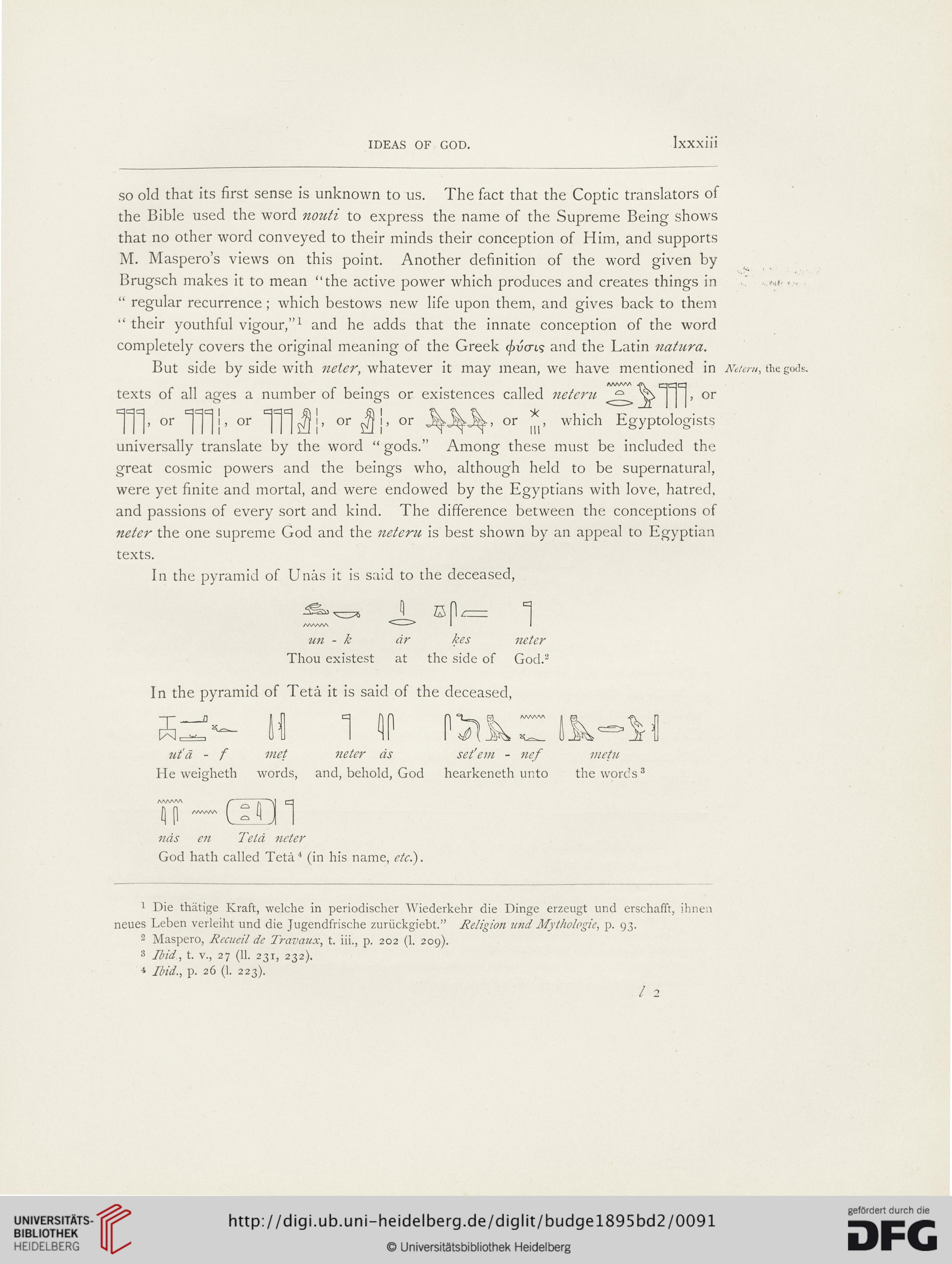IDEAS OF GOD.
Ixxxiii
so old that its first sense is unknown to us. The fact that the Coptic translators of
the Bible used the word nouti to express the name of the Supreme Being shows
that no other word conveyed to their minds their conception of Him, and supports
M. Maspero’s views on this point. Another definition of the word given by
Brugsch makes it to mean “the active power which produces and creates things in m> -
“ regular recurrence; which bestows new life upon them, and gives back to them
“ their youthful vigour,”1 and he adds that the innate conception of the word
completely covers the original meaning of the Greek and the Latin natura.
But side by side with neter, whatever it may mean, we have mentioned in Neteru, thegods.
texts of all ages a number of beings or existences called neteru ^ , or
'Yf], or '=j=fi> or Yi\’ or ^i’ or or *p which Egyptologists
universally translate by the word “ gods.” Among these must be included the
great cosmic powers and the beings who, although helcl to be supernatural,
were yet finite and mortal, and were endowed by the Egyptians with love, hatred,
and passions of every sort and kind. The difference between the conceptions of
neter the one supreme God and the netenc is best shown by an appeal to Egyptian
texts.
In the pyramid of Unas it is said to the cleceased,
^ 17s fi /-
/WWVS I
un - k dr kes
Thou existest at the side of
1
neter
God.2 3
In the pyramid of Teta it is said of the deceased,
uta - f met neter ds
He weigheth words, and, behold, God
hearkeneth unto
metu
the words 3
w — dH!
nds en Tela neter
God hath called Teta4 (in his name, etc.).
1 Die thatige Kraft, welche in periodischer Wiederkehr die Dinge erzeugt und erschafft, ihnen
neues Leben verleiht und die Jugendfrische zuriickgiebt.” Religion und Mythologie, p. 93.
3 Maspero, Recueil de Travaux, t. iii., p. 202 (1. 209).
3 Ibid., t. v., 27 (II. 231, 232).
4 Ibid., p. 26 (1. 223).
/ 2
Ixxxiii
so old that its first sense is unknown to us. The fact that the Coptic translators of
the Bible used the word nouti to express the name of the Supreme Being shows
that no other word conveyed to their minds their conception of Him, and supports
M. Maspero’s views on this point. Another definition of the word given by
Brugsch makes it to mean “the active power which produces and creates things in m> -
“ regular recurrence; which bestows new life upon them, and gives back to them
“ their youthful vigour,”1 and he adds that the innate conception of the word
completely covers the original meaning of the Greek and the Latin natura.
But side by side with neter, whatever it may mean, we have mentioned in Neteru, thegods.
texts of all ages a number of beings or existences called neteru ^ , or
'Yf], or '=j=fi> or Yi\’ or ^i’ or or *p which Egyptologists
universally translate by the word “ gods.” Among these must be included the
great cosmic powers and the beings who, although helcl to be supernatural,
were yet finite and mortal, and were endowed by the Egyptians with love, hatred,
and passions of every sort and kind. The difference between the conceptions of
neter the one supreme God and the netenc is best shown by an appeal to Egyptian
texts.
In the pyramid of Unas it is said to the cleceased,
^ 17s fi /-
/WWVS I
un - k dr kes
Thou existest at the side of
1
neter
God.2 3
In the pyramid of Teta it is said of the deceased,
uta - f met neter ds
He weigheth words, and, behold, God
hearkeneth unto
metu
the words 3
w — dH!
nds en Tela neter
God hath called Teta4 (in his name, etc.).
1 Die thatige Kraft, welche in periodischer Wiederkehr die Dinge erzeugt und erschafft, ihnen
neues Leben verleiht und die Jugendfrische zuriickgiebt.” Religion und Mythologie, p. 93.
3 Maspero, Recueil de Travaux, t. iii., p. 202 (1. 209).
3 Ibid., t. v., 27 (II. 231, 232).
4 Ibid., p. 26 (1. 223).
/ 2




